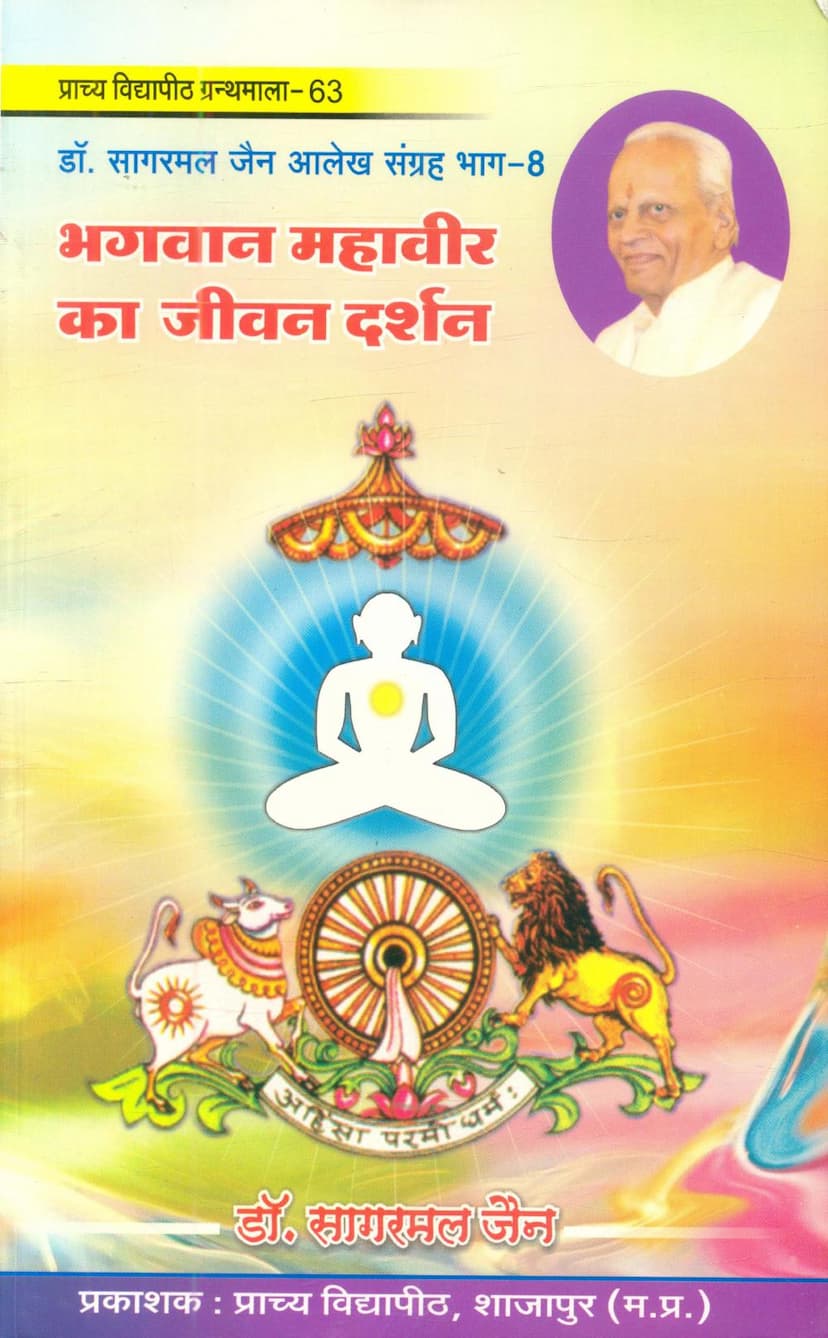Bhagwan Mahavir Ka Jivan Darshan
Added to library: September 1, 2025

Summary
Here's a comprehensive summary in English of the provided Jain text, focusing on the core content about Bhagwan Mahavir's life and philosophy:
Book Title: Bhagwan Mahavir Ka Jivan Darshan (The Life Philosophy of Bhagwan Mahavir) Author: Sagarmal Jain Publisher: Prachya Vidyapith, Shajapur (M.P.) Publication Year: 2015-16
This book, "Bhagwan Mahavir Ka Jivan Darshan," is a collection of insightful articles by the renowned scholar Dr. Sagarmal Jain, dedicated to exploring the life and philosophy of Bhagwan Mahavir. The publication aims to consolidate Dr. Jain's extensive writings on Jainism, which have appeared in various journals and books over fifty years.
The book delves into Bhagwan Mahavir's teachings, emphasizing their relevance to contemporary challenges. Dr. Jain argues that Mahavir's philosophy offers solutions to the pervasive issues of mental conflict, social and ethnic strife, ideological clashes, and economic disparities that plague the modern world.
Key Themes and Concepts Discussed:
-
Mahavir's Life and Philosophy: Dr. Jain presents Mahavir's life as a testament to "generosity in thought and rigor in conduct." He highlights Mahavir's renunciation of a royal life for spiritual pursuit, driven by compassion for the world's suffering and a desire to establish an ideal for humanity's welfare. The author stresses that true welfare (lokmangal) requires rising above personal desires and ego.
-
Ideological Broadness and Tolerance: Mahavir is characterized by his profound ideological liberality and tolerance. He never claimed to be founding a new religion or imparting novel doctrines but rather presented the ancient dharma as expounded by the "Aryas" (noble ones) in a spirit of equanimity. His emphasis on not condemning any other viewpoint ("Sabbha suttavaayanam") reflects this profound respect for diverse perspectives.
-
The Concept of "Shraman" and "Nirgranth": Mahavir identified himself as a "Shraman" and a "Nirgranth" (one unbound by inner ties). He taught that true freedom lies in being a "Drashta" (witness) of one's own mind, thoughts, and impulses, urging individuals to look inward for spiritual growth.
-
Ahimsa (Non-violence): Ahimsa is presented as the supreme principle in Jainism, encompassing all virtues. Its essence lies in respecting life in all its forms. The book explores Ahimsa's psychological underpinnings, rooted in the inherent desire for life and happiness in all beings, and the concept of treating others as oneself ("Atmavata sarva bhutesu"). It also discusses the distinction between intentional (dravyā) and unintentional (bhāvā) violence and the practical challenges of achieving absolute Ahimsa in daily life.
-
Anekantavada (Many-sidedness) and Syadvada (Conditional Predication): Mahavir's philosophy of Anekantavada is highlighted as a path to understanding truth from multiple perspectives, fostering intellectual tolerance and preventing dogmatism. Syadvada, as the linguistic expression of Anekantavada, provides a framework for presenting truths conditionally, acknowledging that any statement is true only from a specific viewpoint. This principle is seen as crucial for resolving conflicts and fostering harmony.
-
Aparigraha (Non-possession) and its Relevance: The concept of Aparigraha is traced from the early human society's natural state of non-possession to its development with agriculture and the rise of societal structures. Mahavir's teachings on controlling desires (trishna), limiting accumulation (parigraha parimāṇa), and mindful consumption (upabhoga-paribhoga parimāṇa) are presented as antidotes to economic inequality, exploitation, and social unrest.
-
Social Equality and Dignity of the Individual: Mahavir championed social equality, rejecting caste-based hierarchies. He emphasized that spiritual and moral development, not birth, determines one's worth. His teachings restored human dignity, asserting that each individual is inherently divine and their own master.
-
The Role of the Shravaka (Householder): The book analyzes the evolution of the Shravaka community, highlighting their crucial role in preserving Jain traditions and supporting the monastic order. While acknowledging the shift from character-based influence to wealth and power-based influence in contemporary Jain society, the author stresses the need for renewed adherence to ethical principles.
-
Historical and Geographical Re-evaluation: Several articles in the book critically examine traditional beliefs regarding Mahavir's birthplace, place of enlightenment, and nirvana site. Dr. Jain engages with historical and archaeological evidence, suggesting re-evaluations of commonly accepted locations like Vaishali and Lachwad, proposing alternative sites based on textual and circumstantial evidence.
-
The Date of Mahavir's Nirvana: The book also includes a detailed discussion on the various scholarly attempts to establish the precise date of Mahavir's Nirvana, analyzing both internal Jain traditions and external historical evidence to arrive at a reasoned conclusion, leaning towards E.C. 467 BCE based on cross-referencing historical figures and texts.
In essence, "Bhagwan Mahavir Ka Jivan Darshan" serves as a profound exploration of Mahavir's timeless philosophy, presenting his teachings as a guiding light for navigating the complexities of modern life, promoting peace, harmony, and ethical conduct.